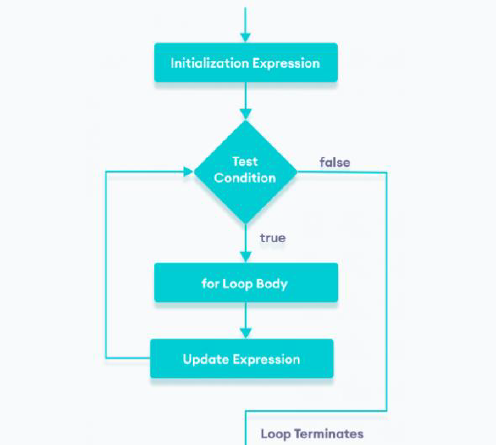C++ for loop
In this article, we are going to learn about for loop in C++
In computer programming, loops are used to repeat a block of code until certain condition is full filled
.
For example, if we want to print a sentence 100 times, instead of writing the same sentence 100 times, we
will use a loop to do so.
That was just a simple example, we can achieve much more efficiency and sophistication in our programs by
making effective use of loops.
There are basically 3 types of loop:
- for loop
- while loop
- do-while loop
Let’s study more about for loop.
C++ for loop
The syntax of for loop is given below:
for(initialization ; condition ; update){
// body of loop
}
In the above syntax:
initialisation initialises a variable executes only ones.- If
condition is true, body of the loop executed
Update updates the initialised value, thus it makes loop to repeat its body

Algorithm Flowchart of for Loop
Example 1:
In this example we’re going to print numbers from 1 to 10. Following is its program:
#include <iostream>
using namespace std;
int main() {
for (int i = 1; i <= 10; ++i) {
cout << i << " ";
}
return 0;
}
Output 1:
1 2 3 4 5 6 7 8 9 10
Explanation of the above program
| Iteration |
Variable |
i <= 10 |
Action |
| 1st |
i = 1 |
true |
1 is printed. i is increased to 2. |
| 2nd |
i = 2 |
true |
2 is printed. i is increased to 3. |
| 3rd |
i = 3 |
true |
3 is printed. i is increased to 4. |
| 4th |
i = 4 |
true |
4 is printed. i is increased to 5. |
| 5th |
i = 5 |
true |
5 is printed. i is increased to 6. |
| 6th |
i = 6 |
true |
6 is printed. i is increased to 7. |
| 7th |
i = 7 |
true |
7 is printed. i is increased to 8. |
| 8th |
i = 8 |
true |
8 is printed. i is increased to 9. |
| 9th |
i = 9 |
true |
9 is printed. i is increased to 10. |
| 10th |
i = 10 |
true |
10 is printed. i is increased to 11. |
| 11th |
i = 11 |
false |
loop is terminated. |
Hope you’ve understood the tracing of above example, now guess the working of below example.
Example 2:
Following program prints ‘Hi !’ five times on the console.
#include <iostream>
using namespace std;
int main() {
for (int i = 1; i <= 5; ++i) {
cout << "Hi ! " << endl;
}
return 0;
}
Output :
Hi !
Hi !
Hi !
Hi !
Hi !
Example 3:
The following program prints the sum of 1st 'n' natural number, 'n'
will be taken by the user.
#include <iostream>
using namespace std;
int main() {
int num, sum;
sum = 0;
cout << "Enter a positive integer: ";
cin >> num;
for (int count = 1; count <= num; ++count) {
sum += count;
}
cout << "Sum = " << sum << endl;
return 0;
}
Output :
Suppose user inputs 10, i.e. num = 10
Enter a positive integer: 10
Sum = 55
The explanation is given below,
In the above example, we have two variables num and sum. The
sum variable is assigned with 0 and the num variable is
assigned with the value provided by the user.
Here in the for loop :-
-
int count = 1; : initializes the count variable
count <= num : runs the loop as long as count is less than or equal to
num++count : increases the count variable by 1 in each
iteration- When count becomes 11, the condition is
false and
sum will be equal to 0 + 1 + 2 + ... + 10.
C++ infinite for loop
An infinite loop occurs when condition for running a loop always true. As a result of this the block of
code inside the body of loop keeps on repeating infinitely (until the memory if full).
Let’s look on an example of it using for loop.
// infinite for loop
for(int i = 1; i > 0; i++) {
// block of code
}
In the above program, the condition is always true which will then run the
code for infinite times.

